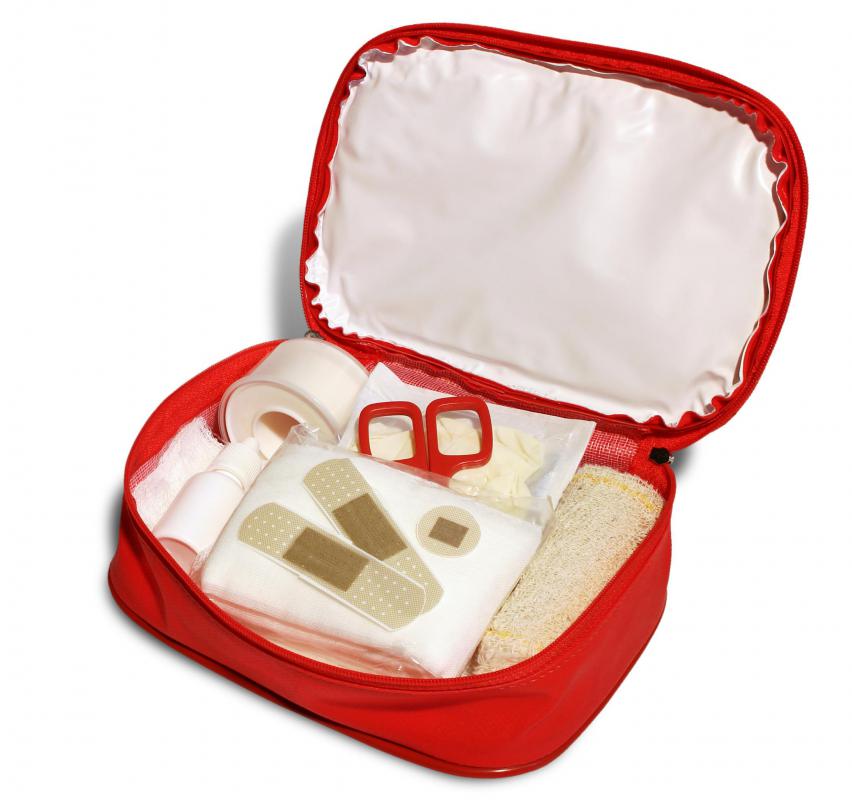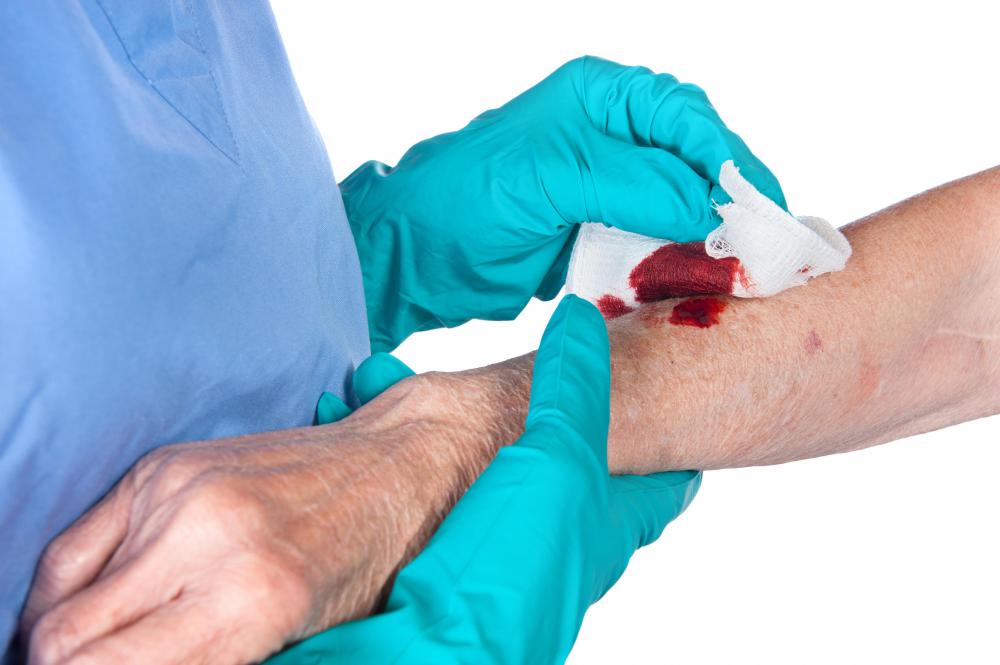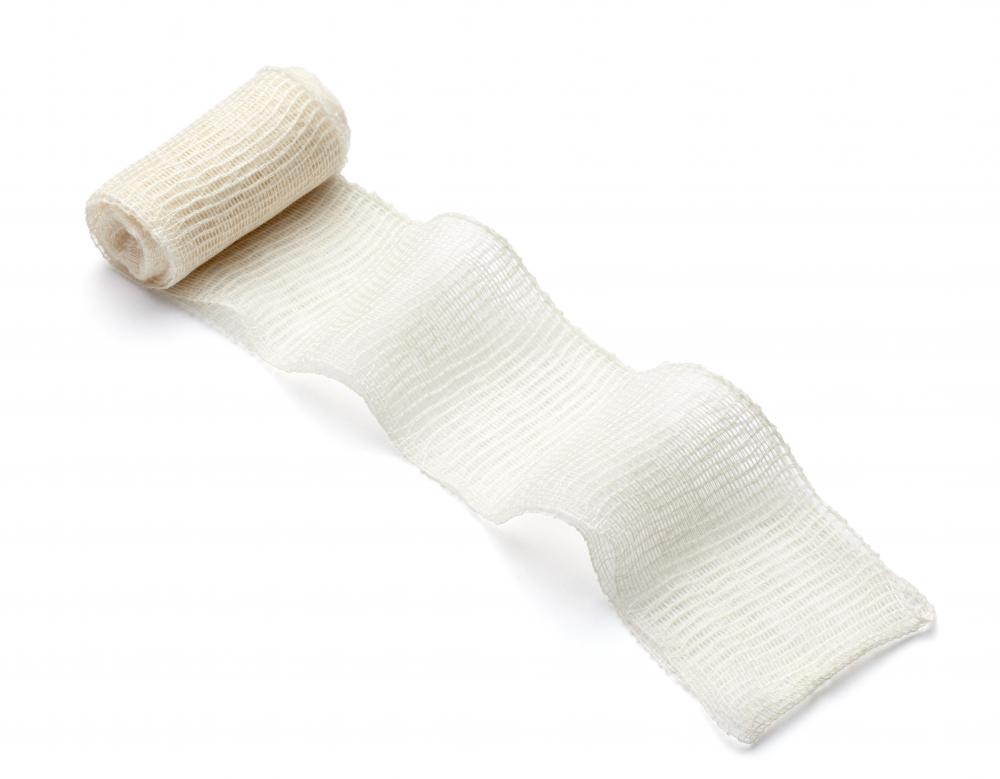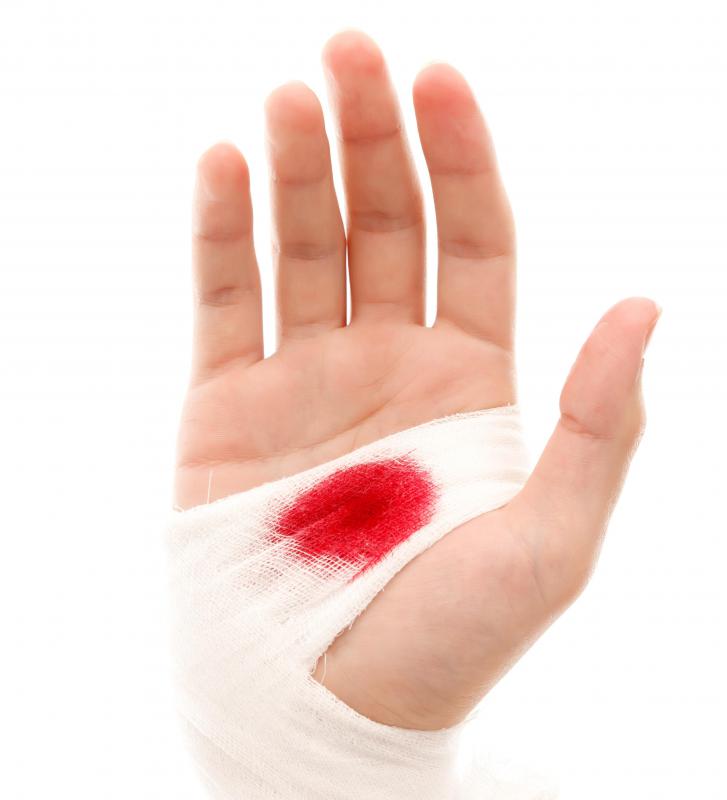At TheHealthBoard, we're committed to delivering accurate, trustworthy information. Our expert-authored content is rigorously fact-checked and sourced from credible authorities. Discover how we uphold the highest standards in providing you with reliable knowledge.
What is Sterile Gauze?
Sterile gauze is a medical supply product that is used to both dress and protect wounds. It’s usually made of cotton or other natural fibers, and its main job is to absorb fluids and wick them off of the surface of the skin or the site of an injury or wound. It is usually manufactured to accommodate a wide range of uses. Most portable first aid kits contain both gauze wraps and pads, and they’re used widely in most hospitals and health clinics, too.
Basics of Manufacturing and Use

Gauze is usually considered to be a more or less “standard” medical product, and it comes in many different sizes, shapes, and thicknesses. It almost always has a soft, mesh-like look, and some people describe it as somewhat tissue-like. At first glance it doesn’t always look very substantial, but this is part of its core usefulness: it expands in contact with moisture, which can help people heal faster and can help keep things like surgical sites clean and clear of blood.

This sort of gauze usually comes in a couple of different formats depending on the intended use. It can come as a roll or as a pad, and is available in a variety of thicknesses and densities. It’s almost always made of cotton and natural fibers that are specially selected for their absorption capacity. In order to be “sterile,” the gauze is usually packed in sealed containers or packages that medical providers should take care in opening to avoid contamination. The people who need this product the most — namely, people with open wounds or bleeding incision sites — are often at a high risk of infection already. Introducing contaminants on gauze or other bandaging can compound that risk and can often create new problems.
Fluid Absorption

Fluid absorption is the main role of any sort of sterile gauze. The substance, which so often seems thin and dry in the package, traps things like blood in much the same way a sponge would. This quality makes gauze a good choice for everything from cuts and scrapes to major surgical incisions.
Doctors and dentists frequently use it to absorb fluids during a variety of procedures. A dentist may use rolls of gauze to absorb excess saliva and blood while extracting a tooth, for instance, and surgeons who are operating often pack open body cavities with gauze rolls to keep blood from pooling and to offer a better, clearer view of what is happening internally.
Gauze can also absorb any blood or fluids that seep out of a wound. This can help prevent damage to clothing or the contamination of other objects. Blood is generally considered to be a contaminant because of its potential to spread disease.
Wound Protection

Most wounds also need to be protected, and gauze provides a cushioned barrier against the elements and any impact to the area. There are gauze rolls that are manufactured just for this purpose. Sterile padding roll gauze, in particular, can create a cushioned layer of protection.
Bandaging a wound can also help prevent the wound from drying out. Doctors may advocate the use of moist bandages for certain types of injuries. While some studies have shown that a moist wound heals more efficiently than a dry one, dry gauze is still predominantly used. Many medical schools and first aid training courses teach that using dry gauze is the best way to treat a wound.
Usage Tips

A person administering first aid usually begins by assessing the patient’s wound to determine what type of bandaging it may require. Choosing the right type of gauze is really important here. Some products are specifically created to add cushioning by use of a wider weave, while others feature a tight weave to increase absorbency.
If the wound is small, the person assisting may be able to clean the site, apply antibiotic ointment, and protect the injury with a pre-gauzed bandage that is suitable for the area. Many commercial bandages for small cuts and scrapes consist of a plastic or a cloth strip that has adhesive and a sterile gauze pad already attached on one side. Big wounds may require more extensive cleaning and bandaging with a large form of gauze.

Sanitary gauze acts as a barrier to prevent contaminants from entering the area. As such, people should be sure to keep their hands clean and to wash and dry the area regularly. It’s also important to change the bandages and gauze regularly, particularly when there’s a lot of blood or other fluids. Not only will fresh applications be more effective in terms of absorption and moisture levels, they can also help prevent secondary infection.
AS FEATURED ON:
AS FEATURED ON:

















Discussion Comments
I've actually never heard of moist gauze bandages before. I had no idea that some wounds should be kept moist so they can heal better. I thought it didn't really matter if the wound was wet or dry as long as it was treated and covered!
I think I'm going to add some moist sterile gauze to my home first aid kit, just to be safe. I have a friend who is a doctor, so I'm going to ask her which kinds of wounds should be kept moist so I'll know if I ever have an emergency.
@SZapper - I don't much like having gauze in my mouth either. I had a tooth pulled, and the dentist packed the area with sterile gauze dressing. It drove me crazy having it in there, but it was the best thing to keep the wound packed with!
I do like to use sterile gauze for first aid though. I prefer the padded sterile gauze. I think that if a wound is bad enough it needs a gauze dressing, it should probably be protected with some padding too! It doesn't feel very good to hit a wound on something while it's still healing, so I think padded gauze is the answer to this problem.
Like the article said, I always keep a few sterile gauze rolls in my first aid kit at home. You never know when you might need them, and they're so versatile. You can use them for all different kinds of wounds!
I have to say, I like using gauze for first aid, but I hate having gauze in my mouth when I get dental work done. I hate how the texture feels in my mouth, and I'm always paranoid the gauze is going to dislodge itself and fall down my throat somehow. I know this isn't likely, but it still scares me!
Post your comments